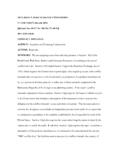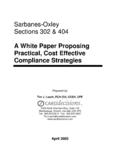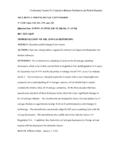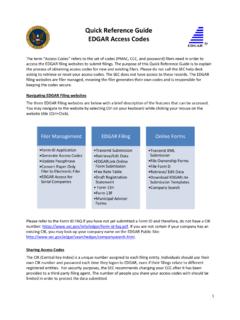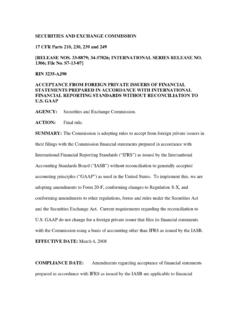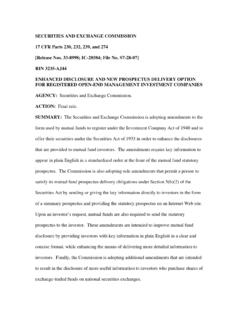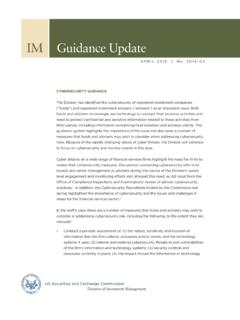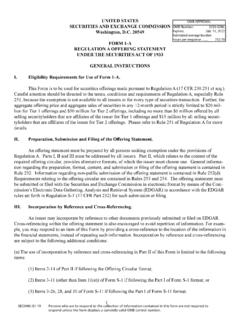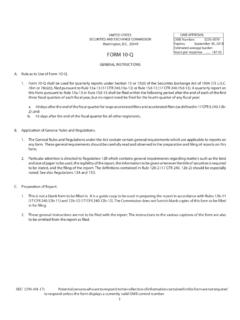Transcription of Final Rule: Investment Company Liquidity Risk Management ...
1 SECURITIES AND EXCHANGE COMMISSION. 17 CFR Parts 210, 270, 274. Release Nos. 33- 10233; IC- 32315; File No. S7-16-15. RIN 3235-AL61. Investment Company Liquidity Risk Management Programs AGENCY: Securities and Exchange Commission. ACTION: Final rule. SUMMARY: The Securities and Exchange Commission is adopting new rules, a new form and amendments to a rule and forms designed to promote effective Liquidity risk Management throughout the open-end Investment Company industry, thereby reducing the risk that funds will be unable to meet their redemption obligations and mitigating dilution of the interests of fund shareholders. The amendments also seek to enhance disclosure regarding fund Liquidity and redemption practices. The Commission is adopting new rule 22e-4, which requires each registered open-end Management Investment Company , including open-end exchange-traded funds ( ETFs ) but not including money market funds, to establish a Liquidity risk Management program.
2 Rule 22e-4 also requires principal underwriters and depositors of unit Investment trusts ( UITs ) to engage in a limited Liquidity review. The Commission is also adopting amendments to Form N-1A regarding the disclosure of fund policies concerning the redemption of fund shares. The Commission also is adopting new rule 30b1-10 and Form N-LIQUID that generally will require a fund to confidentially notify the Commission when the fund's level of illiquid investments that are assets exceeds 15% of its net assets or when its highly liquid investments that are assets fall below its minimum for more than a specified period of time. The Commission also is adopting certain sections of Forms N-PORT and N-CEN that will require disclosure of 1. certain information regarding the Liquidity of a fund's holdings and the fund's Liquidity risk Management practices. DATES: Effective Dates: This rule is effective January 17, 2017 except for the amendments to Form N-CEN (referenced in 17 CFR ) which are effective June 1, 2018.
3 Compliance Dates: The applicable compliance dates are discussed in section of this Final rule. FOR FURTHER INFORMATION CONTACT: Zeena Abdul-Rahman, John Foley, Andrea Ottomanelli Magovern, Naseem Nixon, Amanda Hollander Wagner, Senior Counsels; Thoreau Bartmann, Melissa Gainor, Senior Special Counsels; or Kathleen Joaquin, Senior Financial Analyst, Investment Company Rulemaking Office, at (202) 551-6792, Ryan Moore, Assistant Chief Accountant, or Matt Giordano, Chief Accountant at (202) 551-6918, Office of the Chief Accountant, Division of Investment Management , Securities and Exchange Commission, 100 F. Street, NE, Washington, DC 20549-8549. SUPPLEMENTARY INFORMATION: The Securities and Exchange Commission (the Commission ) is adopting new rules 22e-4 [17 CFR ] and 30b1-10 [17 CFR. ], under the Investment Company Act of 1940 [15 80a-1 et seq.]. ( Investment Company Act or Act ); new Form N-LIQUID [referenced in 17 CFR 10] under the Investment Company Act; amendments to Form N-1A [referenced in 17 CFR ] under the Investment Company Act and the Securities Act of 1933.
4 ( Securities Act ) [15 77a et seq.]; and adopting sections to Form N-PORT [referenced in 2. 17 CFR ] and Form N-CEN [referenced in 17 CFR ] under the Investment Company Act. 1. TABLE OF CONTENTS: I. 5. II. BACKGROUND .. 11. A. OPEN-END 11. B. THE ROLE OF Liquidity IN OPEN-END FUNDS .. 14. C. RECENT DEVELOPMENTS IN THE OPEN-END FUND INDUSTRY .. 34. D. OVERVIEW OF CURRENT PRACTICES .. 39. E. RULEMAKING ADOPTION OVERVIEW .. 41. III. DISCUSSION .. 46. A. PROGRAM REQUIREMENT AND SCOPE OF RULE 22E-4 .. 46. B. ASSESSMENT, Management , AND REVIEW OF Liquidity RISK .. 54. C. CLASSIFYING THE Liquidity OF A FUND'S PORTFOLIO INVESTMENTS, AND DISCLOSURE AND. REPORTING REQUIREMENTS REGARDING PORTFOLIO INVESTMENTS' Liquidity . CLASSIFICATIONS .. 89. D. HIGHLY LIQUID Investment 195. E. LIMITATION ON FUNDS' ILLIQUID INVESTMENTS .. 230. F. POLICIES AND PROCEDURES REGARDING REDEMPTIONS IN KIND.
5 239. G. CROSS-TRADES .. 243. H. BOARD APPROVAL AND DESIGNATION OF PROGRAM ADMINISTRATIVE RESPONSIBILITIES 249. I. RECORDKEEPING REQUIREMENTS .. 259. 1. Unless otherwise noted, all references to statutory sections are to the Investment Company Act, and all references to rules under the Investment Company Act are to Title 17, Part 270 of the Code of Federal Regulations [17 CFR 270]. 3. J. 260. K. LIMITATION ON UNIT Investment TRUSTS' INVESTMENTS IN ILLIQUID INVESTMENTS .. 279. L. DISCLOSURE AND REPORTING REQUIREMENTS REGARDING Liquidity RISK AND Liquidity . RISK Management .. 282. M. EFFECTIVE AND COMPLIANCE DATES .. 307. IV. ECONOMIC ANALYSIS .. 310. A. INTRODUCTION AND PRIMARY GOALS OF REGULATION .. 310. B. ECONOMIC BASELINE .. 315. C. BENEFITS AND COSTS, AND EFFECTS ON EFFICIENCY, COMPETITION, AND CAPITAL. FORMATION .. 328. V. PAPERWORK REDUCTION ACT ANALYSIS .. 396. A. INTRODUCTION.
6 396. B. RULE 397. C. FORM N-PORT .. 409. D. FORM N-LIQUID AND RULE 30B1-10 .. 418. E. FORM N-CEN .. 421. F. FORM N-1A .. 423. VI. Final REGULATORY FLEXIBILITY ACT ANALYSIS .. 428. A. NEED FOR THE RULE .. 429. B. SIGNIFICANT ISSUES RAISED BY PUBLIC COMMENT .. 430. C. SMALL ENTITIES SUBJECT TO THE RULE .. 431. D. PROJECTED REPORTING, RECORDKEEPING, AND OTHER COMPLIANCE REQUIREMENTS .. 431. E. AGENCY ACTION TO MINIMIZE EFFECT ON SMALL ENTITIES .. 435. VII. STATUTORY AUTHORITY AND TEXT OF 436. TEXT OF RULES AND FORMS .. 437. 4. I. INTRODUCTION. Redeemability is a defining feature of open-end Investment companies. 2 At the time the Act was adopted, this feature was recognized as unique to open-end Investment companies, 3 and the Act's classification of Management Investment companies as either open-end ( open-end funds or funds ) 4 or closed-end, upon which several of the Act's other provisions depend, turns on whether the Investment Company 's shareholders have the right to redeem their shares on demand.
7 When the Investment Company Act was enacted, it was understood that redeemability meant that an open-end fund had to have a liquid portfolio. 5 Since the 1940s, the Commission has stated that open-end funds should maintain highly liquid portfolios and recognized that this 2. See Investment Trusts and Investment Companies: Letter from the Acting Chairman of the SEC, A Report on Abuses and Deficiencies in the Organization and Operation of Investment Trusts and Investment Companies (1939), at ( [T]he salient characteristic of the open-end Investment Company was that the investor was given a right of redemption so that he could liquidate his Investment at or about asset value at any time that he was dissatisfied with the Management or for any other reason. ). An open-end Investment Company is required by law to redeem its securities on demand from shareholders at a price approximating their proportionate share of the fund's net asset value ( NAV ) next calculated by the fund after receipt of such redemption request.
8 3. See Investment Trusts and Investment Companies: Hearings on S. 3580 before a Subcomm. of the Senate Comm. on Banking and Currency, 76th Cong., 3d Sess. (1940) ( 1940 Senate Hearings Transcript ), at 453. (Statement of Mahlon E. Traylor) ( Open-end companies are unlike any other type of Investment Company , principally because of the highly important distinguishing feature that their shareholders can, by contract right, withdraw their proportionate interest at will simply by surrendering their shares to the Company for redemption at liquidating value. ). 4. In-Kind ETFs (as defined below) are included when we refer to funds or open-end funds throughout this Release, except in the sections discussing classifying the Liquidity of a fund's portfolio positions and the highly liquid Investment minimum requirement, from which In-Kind ETFs are excepted. We have done this for conciseness and we recognize that these naming conventions differ from the text of rule 22e-4.
9 Additionally, while a money market fund is an open-end Management Investment Company , money market funds are not subject to the rules and amendments we are adopting (except certain amendments to Form N- CEN and Form N-1A) and thus are not included when we refer to funds or open-end funds in this Release except where specified. 5. See Investment Trusts and Investment Companies: Hearings on 10065 before a Subcomm. of the House Comm. on Interstate and Foreign Commerce, 76th Cong., 3d Sess. 112 (1940), at 57 (Statement of Robert E. Healy) ( due to the right of the stockholder to come in and demand a redemption, the [open-end fund] has to keep itself in a very liquid position. That is, it has to be able to turn its securities into money on very short notice. ). 5. may limit their ability to participate in certain transactions in the capital markets. 6 Section 22(e). of the Act enforces the shareholder's right of prompt redemption in open-end funds by compelling such funds to make payment on shareholder redemption requests within seven days of receiving the request.
10 Potential dilution of shareholders' interests in open-end funds also was a significant concern of Congress when drafting the Act and was among the noted abuses that led to the enactment of the Act, as reflected in sections 22(a) and (c). 7. Although the Investment Company Act provides funds with a seven-day window to pay proceeds upon an investor's redemption, the settlement period for open-end fund redemptions has shortened considerably over the years. There are several reasons for shorter settlement periods, including broker-dealer settlement cycle requirements, 8 evolving industry standards, and technological advances in the settlement infrastructure. 9 In addition, many funds state in their prospectuses that investors can ordinarily expect to receive redemption proceeds in shorter 6. See Investment Trusts and Investment Companies: Report of the Securities and Exchange Commission (1942), at 76 ( Open-end Investment companies, because of their security holders' right to compel redemption of their shares by the Company at any time, are compelled to invest their funds predominantly in readily marketable securities.)

